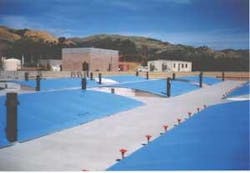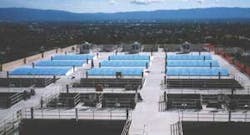Cover System Reduces DBPs While Controlling Algae Growth
by Angela Cheung and Brent Howe
In the fall of 2004, the Operations Division of the Santa Clara Valley Water District started a program called the Operations Council on Excellence. The program was created to support the district’s vision of a cleaner, greener, and leaner operation. At the time, two of the district’s three water treatment plants, Penitencia and Santa Teresa, were undergoing construction to replace chlorine with ozone for primary disinfection.
With the switchover to ozone, the plan was to reduce or eliminate chlorine feed at the head of the plant, thus reducing the formation of disinfection byproducts (DBPs). However, any attempts in the past to reduce chlorine feed have resulted in algal growth on the basins walls, launders, tube settlers, etc. At times, algal growth was significant enough to have caused in-plant taste and odor production.
The water retailers served by the district were expecting substantial reductions in DBPs from ozonation. If pre-chlorination were to continue at the same rate for algae control, the benefits of ozonation would be less pronounced. District staff knew that DBP reduction with algae control could be accomplished in two ways: through the use of alternative oxidants to chlorine or by creating a physical barrier to block the sunlight that algae requires to grow. Both solutions were found to be used effectively at water treatment plants contacted as part of the district’s investigations. Ultimately, district staff chose to go with basin covers because the cost of the basin cover installation can be recovered in about five years through hypochlorite reduction. The idea also encompasses the district vision of “getting cleaner, greener and leaner.”
District staff evaluated three types of basin covers: 1) buoyant fabric covers floating directly on the water, 2) high-strength fabric covers tensioned across a basin opening and suspended above the water, and 3) covers consisting of a structure spanning the basin opening. Fabric, fiberglass and aluminum cover materials were considered. All of the cover styles would block sunlight and thus control algae. Similarly, all the cover styles were manufactured with materials that were NSF 61 approved for drinking water applications.
The Penitencia plant team expressed a strong preference for retractable, structurally supported covers because the basins are frequently taken in and out of service, and this cover style is the easiest for basin viewing by the operations staff and accessing by the maintenance staff.
District staff selected covers from Geomembrane Technologies Inc. (GTI). The structurally supported covers consist of a retractable fabric sheet tensioned over supporting aluminum arches. A decision was made to install the covers on nine 21’ x 31’ openings over the plant’s tube settlers, which were especially prone to algae attachment. This installation would also serve as a test case for other potential applications elsewhere in the district.
GTI custom-designed the structurally supported covers to include special features chosen by the plant team, and to fit around the various pipes and light standards existing around the basin openings. The nine covers were installed in four days in June 2006 while the basins remained in service. Results were immediately apparent, and operators were able to cut back chlorine feed even before the covers were completely installed.
Five months after the covers were installed, plant staff retracted the covers and found the tube settlers to be free of algae. Plant operators have also reduced pre-chlorine feed by more than half. A small amount of chlorine is still used to provide coagulant aid and to control algal growth in uncovered portions of the treatment trains. In the first six months of cover installation, the plant saved $24,000 from lower hypochlorite usage compared to the year before, in line with the projection of $50,000 annual chemical cost savings.
The cost to cover the tube settlers at Penitencia was $258,990, which included material, installation, and field support by the manufacturer. With a life expectancy of 15 to 20 years, the district is expected to recover the cost of the cover installation, and save an additional $500,000 over the life of the covers.
Since the switch to ozonation at the plant, and with the help of the basin covers, total trihalomethanes (THMs) and haloacetic acids (HAA5) leaving the plant are consistently below 40 ug/L and 10 ug/L, respectively.
About the Authors: Angela Cheung is a Senior Engineer with the Santa Clara Valley Water District. She may be contacted at [email protected]. Brent Howe is a Product Manager with Geomembrane Technologies Inc. He may be contacted at [email protected].



